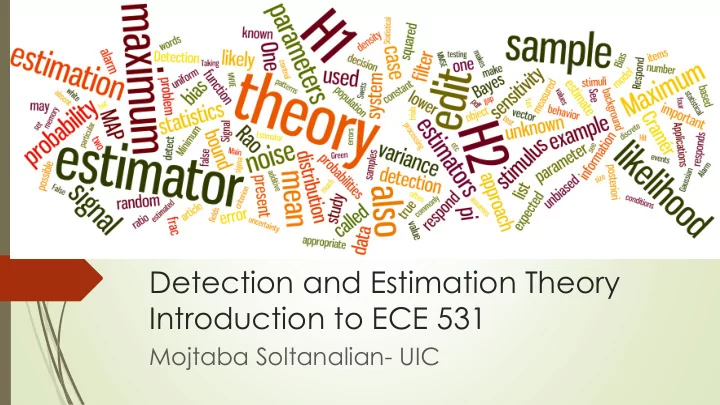

Detection and Estimation Theory Introduction to ECE 531 Mojtaba Soltanalian- UIC
The course Lectures are given Tuesdays and Thursdays, 2:00-3:15pm Office hours: Thursdays 3:45-5:00pm, SEO 1031 Instructor: Prof. Mojtaba Soltanalian office: SEO 1031 email: msol@uic.edu web: http://msol.people.uic.edu/
The course Course webpage: http://msol.people.uic.edu/ECE531 Textbook(s): * Fundamentals of Statistical Signal Processing, Volume 1: Estimation Theory, by Steven M. Kay, Prentice Hall, 1993, and (possibly) * Fundamentals of Statistical Signal Processing, Volume 2: Detection Theory, by Steven M. Kay, Prentice Hall 1998, available in hard copy form at the UIC Bookstore.
The course Style: /Graduate Course with Active Participation/
Introduction Let’s start with a radar example!
Introduction> Radar Example QUIZ
Introduction> Radar Example You can actually explain it in ten seconds!
Introduction> Radar Example Applications in Transportation, Defense, Medical Imaging, Life Sciences, Weather Prediction, Tracking & Localization
Introduction> Radar Example The strongest signals leaking off our planet are radar transmissions, not television or radio. The most powerful radars, such as the one mounted on the Arecibo telescope (used to study the ionosphere and map asteroids) could be detected with a similarly sized antenna at a distance of nearly 1,000 light-years. - Seth Shostak, SETI
Introduction> Estimation Traditionally discussed in STATISTICS. Estimation in Signal Processing: Digital Computers ADC/DAC (Sampling) Signal/Information Processing
Introduction> Estimation The primary focus is on obtaining optimal estimation algorithms that may be implemented on a digital computer. We will work on digital signals/datasets which are typically samples of a continuous-time waveform.
Introduction> Estimation Estimation theory deals with estimating the values of parameters based on measured/empirical data that has a random component. The parameters describe an underlying physical setting in such a way that their value affects the distribution of the measured data. An estimator attempts to approximate the unknown parameters using the measurements.
Introduction> Detection Detection theory is a means to quantify the ability to discern between information-bearing patterns and random patterns (called noise). Typically boils down to a “hypothesis test” problem.
Introduction> Modeling for Detection and Estimation
Introduction> Estimation or Detection – which comes first?
Introduction> Communication Examples
Introduction> Communication Examples
Introduction> Communication Examples
Introduction> System Identification
Introduction> Clustering in Social Networks
Introduction> Parameter Estimation Via Sensor Networks
Next Lecture: Basics- A Refresher
Recommend
More recommend